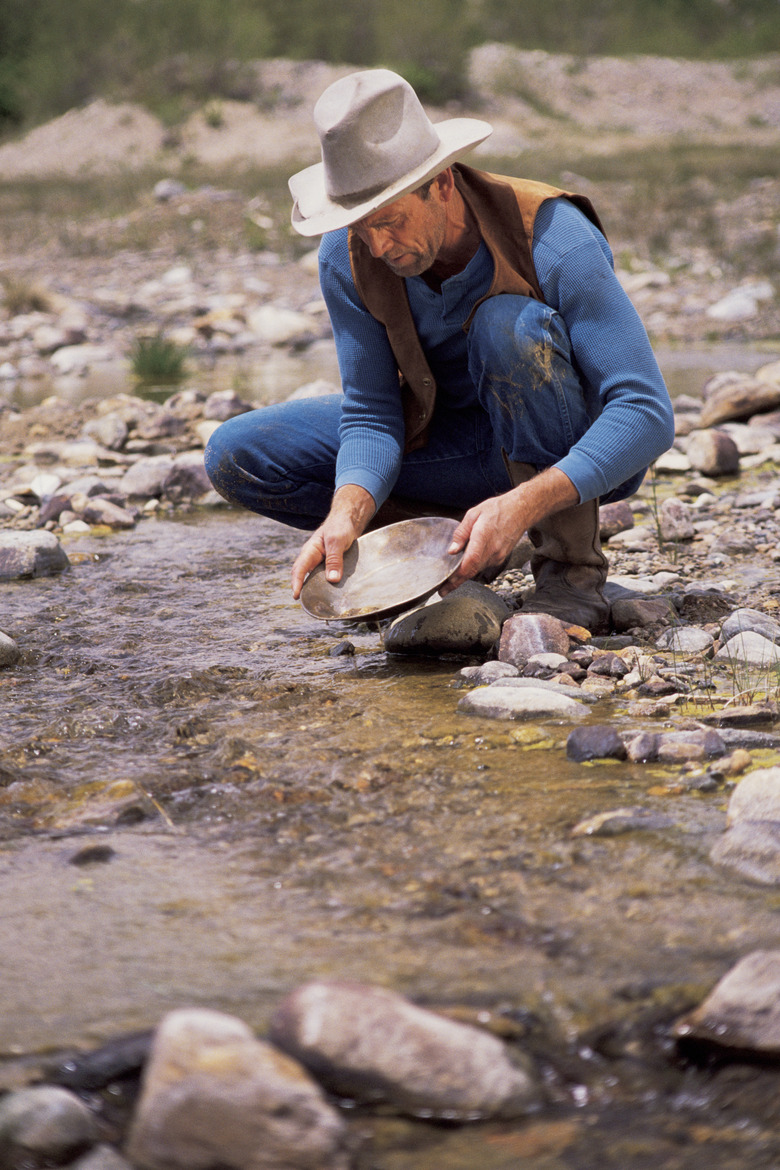How To Use Bleach On Gold Ore To Remove Gold
Gold is an almost non-reactive metal, but halogens — chlorine, bromine, fluorine and iodine — can dissolve it. Chlorine is the cheapest and lightest product that can achieve this. Bleach is the chemical compound sodium hypochlorite. When combined with hydrochloric acid, the mixture produces chlorine that dissolves gold from gold ore. This was the first commercial method used for gold extraction.
Step 1
Place the ore into the mortar and grind it to the size of sand grains. Put the ore grains into a plastic bowl.
Step 2
Add the 35-percent hydrochloric acid to the sodium hypochlorite bleach into a flask or beaker, in a two-to-one ratio of acid to bleach. Ensure that the liquid mixture is at least six times the volume of the ore grains. Wear a face mask and avoid breathing the chlorine fumes the reaction produces.
Step 3
Pour the acid-and-bleach mixture into the plastic bowl with the ore grains and stir. Allow four hours for the gold to dissolve, stirring every 20 minutes. The chlorine reacts with the gold inside the ore to form gold chloride. Filter the ore and bleach solution to remove all the impurities, such as soil and rock fragments. Collect the filtered gold chloride solution in a flask.
Step 4
Place powdered sodium metabisulfate in another flask and dissolve with water. This forms a solution of sodium bisulfate. Add the sodium bisulfate solution to the gold chloride solution. Leave it to settle for four hours.
Step 5
Observe the brown powder at the bottom of the flask. This is the gold that has precipitated out of the solution. Pour off the solution. Place the flask with the wet gold powder on the stove and evaporate the water, leaving the gold powder at the bottom.
Step 6
Collect the powder into a crucible or melting dish. Apply heat with an oxy-butane torch from the side of the dish toward the center, so that the powder melts at 1,947 degrees Fahrenheit. Remove the heat when the gold has melted completely and allow it to cool. Once cooled, the gold is ready for fashioning into ornaments.
Things Needed
- Small pieces of gold ore totaling the size of a large plum
- Bleach (sodium hypochlorite)
- 35 percent hydrochloric acid
- Water
- Filter funnel
- Standard or coffee filter paper
- Sodium metabisulfate powder
- Plastic bowl or bucket
- Glass flasks or beakers
- Face mask
- Gloves
- Stirrer
- Stove
- Crucible or melting dish
- Oxy-butane torch
- Cast iron mortar bowl about 5 inches by 6 inches and pestle
TL;DR (Too Long; Didn't Read)
Wear gloves throughout the process, as acids are very corrosive.
Take caution when mixing acid and bleach. This is an exothermic process, meaning that the flask containing the acid-and-bleach mixture becomes very hot.
Warning
Perform the job outdoors or in a fume cupboard if possible, as chlorine is a toxic gas.
Cite This Article
MLA
Kielmas, Maria. "How To Use Bleach On Gold Ore To Remove Gold" sciencing.com, https://www.sciencing.com/use-bleach-gold-ore-remove-gold-12101047/. 24 April 2017.
APA
Kielmas, Maria. (2017, April 24). How To Use Bleach On Gold Ore To Remove Gold. sciencing.com. Retrieved from https://www.sciencing.com/use-bleach-gold-ore-remove-gold-12101047/
Chicago
Kielmas, Maria. How To Use Bleach On Gold Ore To Remove Gold last modified March 24, 2022. https://www.sciencing.com/use-bleach-gold-ore-remove-gold-12101047/
